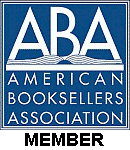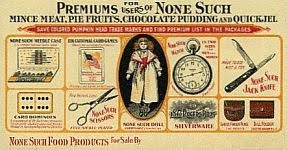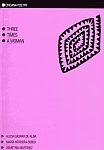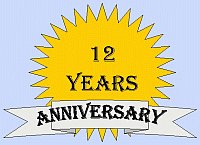by Steven Williams
 Traditional mincemeat aka mince-meat was basically a mixture of fruits and spices that was cooked with minced meat and or beef suet and doused with brandy, rum, or whiskey. Mince-meat improves and becomes moister as the weeks pass and so is generally allowed to mature for at least four weeks before using. If a person is attempting to make a more traditional mince-meat filling for mincemeat pies, the maturing mix should be checked regularly during the aging process in order to prevent it from becoming dry. Stir the maturing mixture and if it does appear to be dry or drying out, add about one quarter of a cup of dry sherry or brandy.
Traditional mincemeat aka mince-meat was basically a mixture of fruits and spices that was cooked with minced meat and or beef suet and doused with brandy, rum, or whiskey. Mince-meat improves and becomes moister as the weeks pass and so is generally allowed to mature for at least four weeks before using. If a person is attempting to make a more traditional mince-meat filling for mincemeat pies, the maturing mix should be checked regularly during the aging process in order to prevent it from becoming dry. Stir the maturing mixture and if it does appear to be dry or drying out, add about one quarter of a cup of dry sherry or brandy. The Modern Cook
The Modern Cookby Charles Elmé Francatelli (1805-1876)
the 1901 printing of the 1862 3rd edition
page 469
Recipe 1444
MINCE-MEAT
"Thoroughly cleanse four pounds of currants, and remove the stones from four pounds of raisins; cut up two pounds of candied citron, one pound of candied lemon, and one pound of orange-peel, into shreds, or very small dice; remove the skin, and then chop four pounds of fresh beef-suet, and place this with the currants and the candied peel in an earthen pan; next chop the raisins with four pounds of peeled apples, and add them to the other ingredients. Trim away all the sinewy parts from eight pounds of roasted sirloin of beef, and chop all the lean of the meat quite fine; this will produce about four pounds, which must also be placed in the pan.
 To the foregoing must now be added four pounds of moist sugar, four ounces of ground spice—consisting of nutmegs, cloves, and cinnamon in equal proportions, with the grated rind of twelve oranges, and of the same number of lemons; the whole must then be thoroughly mixed together, and pressed down to a level in the pan. Two bottles of brandy, and a like quantity of Madeira, sherry or port, should be poured into the mince-meat. Put the lid on the pan, place a cloth over it, and tie it down close, so as to exclude the air as much as possible, and also to prevent the evaporation of the brandy, etc. The mince-meat should be kept in a cool place, and will be fit for use a fortnight after it is made."
To the foregoing must now be added four pounds of moist sugar, four ounces of ground spice—consisting of nutmegs, cloves, and cinnamon in equal proportions, with the grated rind of twelve oranges, and of the same number of lemons; the whole must then be thoroughly mixed together, and pressed down to a level in the pan. Two bottles of brandy, and a like quantity of Madeira, sherry or port, should be poured into the mince-meat. Put the lid on the pan, place a cloth over it, and tie it down close, so as to exclude the air as much as possible, and also to prevent the evaporation of the brandy, etc. The mince-meat should be kept in a cool place, and will be fit for use a fortnight after it is made."(Editor's note: the following two recipes are related recipes from the same book)
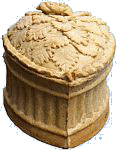 Recipe 1445
Recipe 1445LEMON MINCE-MEAT
"Boil four lemons till quite tender, then pound them in a mortar or chop them up while warm, adding to them two pounds of pounded loaf sugar; let this stand till next day, then add two pounds of suet, two pounds of currants, one pound of raisins chopped, a little brandy, one ounce of mixed spice, and port wine, to taste, say half a pint of brandy and wine together."
Recipe 1446
MINCE MEAT, A LA ROYALE
"To equal proportions of roast-beef, raisins, currants, suet, candied citron, orange, lemon, spices and sugar, add a proportionate weight of stewed pears and preserved ginger, the grated rind of three dozen oranges and lemons, and also their juice, one bottle of old rum, one bottle of brandy, and two of old port."
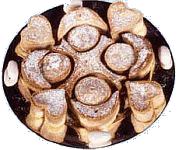 Mincemeat seems to have developed as a way of preserving meat without salting or smoking about five hundred years ago in England, but by the middle of the eighteenth century (1700s) both English and American mince pies without any meat were a common variation. Contemporary American and English cooking traditions sometimes include one version or another of a combination mince-meat and fruit pie at holiday dinners, not unlike the decision to include plum pudding.
Mincemeat seems to have developed as a way of preserving meat without salting or smoking about five hundred years ago in England, but by the middle of the eighteenth century (1700s) both English and American mince pies without any meat were a common variation. Contemporary American and English cooking traditions sometimes include one version or another of a combination mince-meat and fruit pie at holiday dinners, not unlike the decision to include plum pudding.This type of mince-meat and fruit pie seems to have developed out of the remnants of a medieval food tradition of spiced meat dishes, usually minced mutton, that survived because of their association with Christmas. Because of this association, these mince-meat and fruit pies in time sometimes came to be known as Christmas Pies.
 Medieval mince pie was originally made in an oblong casings (coffin or cradle shaped). Over the years, the pies grew smaller, the shape of the pie was gradually changed from oblong to round, and the meat content was gradually reduced until the pies were simply filled with a mixture of suet, spices and dried fruit that had been steeped and cured in brandy beforehand. This filling was put into little pastry cases that were covered with pastry lids and then baked in an oven.
Medieval mince pie was originally made in an oblong casings (coffin or cradle shaped). Over the years, the pies grew smaller, the shape of the pie was gradually changed from oblong to round, and the meat content was gradually reduced until the pies were simply filled with a mixture of suet, spices and dried fruit that had been steeped and cured in brandy beforehand. This filling was put into little pastry cases that were covered with pastry lids and then baked in an oven.The most notable medieval English-language culinary manuscripts include The Forme of Cury (circa 1390) and Noble Boke off Cookry Ffor a Prynce Houssolde or eny other Estately Houssolde (circa 1467). Much of the material from these two manuscripts has been incorporated into Two Fifteenth-Century Cookery-Books edited by Thomas Austin (1888). The former of these manuscripts has been republished as The Forme of Cury, A Roll of Ancient English Cookery, Cimpiled, about A.D. 1390, by the Master-Cooks of King Richard II, Presented afterwards to Queen Elizabeth, by Edward Lord Stafford, And now in the Possession of Gustavus Brander, Esq. under the editorship of Samuel Pegge (J. Nichols, 1780). The later manuscript has been republished using its original title under the editorship of Mrs. Alexander Napier (Elliot Stock, 1882).
 The Forme of Cury, A Roll of Ancient English Cookery
The Forme of Cury, A Roll of Ancient English Cookeryedited by Samuel Pegge
London, Printed by J. Nichols, Printer to the Society of Antiquaries
1780 (from a manuscript circa 1390)
Tartlet
"Take veel ysode and grinde it smale, take harde eyren isode and ygrond and do therto with prunes hoole, dates icorue, pyn and Raisons corance, hool spices and powdo, sug, salt, and make a litell coffyn and do this fars therinne, and bake it and sue it forth."
A rewording by the editor for clarity:
Take veal boiled and grind it small. Take ground hard-boiled eggs, and do there-to with whole prunes, cored dates, pine nuts and currants, whole and powdered spices, sugar and salt. And make a little pie shell and do this filling there-in. Cover it and bake it and serve it forth.
(see the Gode Cookery reference in the resources list below)
Though modern associations of pies are as a dessert, "minced" pies and later "mincemeat pies" were initially a main course dish with with more meat than fruit (a mixture of meat, dried fruits, and spices). As fruits and spices became more plentiful in the seventeenth century (1600s), the spiciness of the pies increased accordingly.
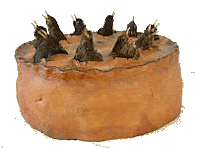 The origins of pies, fruit pies, and fruit and meat pies in general are somewhat hazy but fruit in meat pies during medieval times was very common. Until the second half of the fifteenth century, recipes for meat pies with fruit were much more common than recipes for fruit pies without any meat. Many early meat pies were baked in a very heavy, essentially almost inedible flour and water crust (pie cofyyns or coffins) that was primarily intended as a container for the ingredients that could stand up to the long cooking times typical of these mince-meat pies and later but still early combination mince-meat and fruit pies.
The origins of pies, fruit pies, and fruit and meat pies in general are somewhat hazy but fruit in meat pies during medieval times was very common. Until the second half of the fifteenth century, recipes for meat pies with fruit were much more common than recipes for fruit pies without any meat. Many early meat pies were baked in a very heavy, essentially almost inedible flour and water crust (pie cofyyns or coffins) that was primarily intended as a container for the ingredients that could stand up to the long cooking times typical of these mince-meat pies and later but still early combination mince-meat and fruit pies.It is possible that a lighter and more edible pie crust was developed as an innovation which made fruit pies possible because of the much shorter cooking times required. These lighter crusts and the inclusion of fruit was popular and this popularity contributed to the development and more widely distributed production and consumption of meat and fruit pies as well as new variations of both savory and sweet pies with lighter, more edible crusts for containing them.
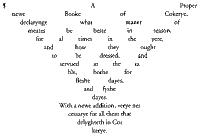 A Proper newe Booke of Cokerye (1545)
A Proper newe Booke of Cokerye (1545)
To Make Short Paest for Tarte
"Take fyne floure and a cursey of fayre water and a dysche of swete butter and a lyttel saffron, and the yolckes of two egges and make it thynne and as tender as ye maye."
Das Kochbuch der Sabina Welserin
English-language translation by Valoise Armstrong
1553 manuscript
Recipe 61
To make a pastry dough for all shaped pies
"Take flour, the best that you can get, about two handfuls, depending on how large or small you would have the pie. Put it on the table and with a knife stir in two eggs and a little salt. Put water in a small pan and a piece of fat the size of two good eggs, let it all dissolve together and boil. Afterwards pour it on the flour on the table and make a strong dough and work it well, however you feel is right. If it is summer, one must take meat broth instead of water and in the place of the fat the skimmings from the broth. When the dough is kneaded, then make of it a round ball and draw it out well on the sides with the fingers or with a rolling pin, so that in the middle a raised area remains, then let it chill in the cold. 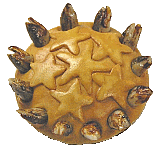 Afterwards shape the dough as I have pointed out to you. Also reserve dough for the cover and roll it out into a cover and take water and spread it over the top of the cover and the top of the formed pastry shell and join it together well with the fingers. Leave a small hole. And see that it is pressed together well, so that it does not come open. Blow in the small hole which you have left, then the cover will lift itself up. Then quickly press the hole closed. Afterwards put it in the oven. Sprinkle flour in the dish beforehand. Take care that the oven is properly heated, then it will be a pretty pastry. The dough for all shaped pastries is made in this manner."
Afterwards shape the dough as I have pointed out to you. Also reserve dough for the cover and roll it out into a cover and take water and spread it over the top of the cover and the top of the formed pastry shell and join it together well with the fingers. Leave a small hole. And see that it is pressed together well, so that it does not come open. Blow in the small hole which you have left, then the cover will lift itself up. Then quickly press the hole closed. Afterwards put it in the oven. Sprinkle flour in the dish beforehand. Take care that the oven is properly heated, then it will be a pretty pastry. The dough for all shaped pastries is made in this manner."
 Reflecting the historical reality of this trend, out of a survey by one food historian of about twenty English, French, and German cookbooks produced from the fourteenth century (1300s) to the sixteenth century (1500s), only about one percent or less of the older books' recipes were for fruit-only pies. In contrast, the percentage of recipes for fruit pies without any meat had increased to about twelve percent in the sixteenth century books surveyed. This historian also notes that this trend seemed to be most clearly indicated in German-language cookbooks. Contributing to the trend towards the development of a 'modern' mincemeat pie, by the seventeenth century (1600s), supplies of both fruit and spices had became more reliable, plentiful, and thus economically affordable and so this seems to have been a significant factor contributing to the increasing percentage fruit content in mince-meat pies as well as their increasing spiciness.
Reflecting the historical reality of this trend, out of a survey by one food historian of about twenty English, French, and German cookbooks produced from the fourteenth century (1300s) to the sixteenth century (1500s), only about one percent or less of the older books' recipes were for fruit-only pies. In contrast, the percentage of recipes for fruit pies without any meat had increased to about twelve percent in the sixteenth century books surveyed. This historian also notes that this trend seemed to be most clearly indicated in German-language cookbooks. Contributing to the trend towards the development of a 'modern' mincemeat pie, by the seventeenth century (1600s), supplies of both fruit and spices had became more reliable, plentiful, and thus economically affordable and so this seems to have been a significant factor contributing to the increasing percentage fruit content in mince-meat pies as well as their increasing spiciness. The earliest printed versions of English mince-meat recipes appeared in the mid to late sixteenth century. One of the earliest of these printed mince-meat pie recipes is included in A Proper newe Booke of Cokerye (1545), one of the earliest printed English-language cookbooks. This book also includes, in context, valuable information about contemporary Tudor domestic life, cookery, and feasts. The collection of recipes in this book is notable for having several recipes for pie crust. This is significant because only a very small number early pie crust recipes have survived. One of the recipes from this book, To make Pyes, is of particular interest because it is very similar to a modern mince-meat with fruit pie (see To make Pyes below).
The earliest printed versions of English mince-meat recipes appeared in the mid to late sixteenth century. One of the earliest of these printed mince-meat pie recipes is included in A Proper newe Booke of Cokerye (1545), one of the earliest printed English-language cookbooks. This book also includes, in context, valuable information about contemporary Tudor domestic life, cookery, and feasts. The collection of recipes in this book is notable for having several recipes for pie crust. This is significant because only a very small number early pie crust recipes have survived. One of the recipes from this book, To make Pyes, is of particular interest because it is very similar to a modern mince-meat with fruit pie (see To make Pyes below).A Proper newe Booke of Cokerye was published in editions of 1545, circa 1557-1558, 1575, and 1576. The full title of the book is A Proper newe Booke of Cokerye, declarynge what maner of meates be beste in season, for all times in the yere, and how they ought to be dressed, and served at the table, bothe for fleshe dayes, and fyshe dayes. With a newe addition verye necessarye for all them that dwlyghteth in Cokerye. Imprynted at London, in Crede Lane, by John Kynge and Thomas Marche [undated, circa 1557-1558].
 There is a 1913 facsimile edition edited by Catherine Frances Frere aka C. F. Frere. An electronic version of the book text, excluding the Frere introduction, glossary, and notes, is available online (as of late 2009).
There is a 1913 facsimile edition edited by Catherine Frances Frere aka C. F. Frere. An electronic version of the book text, excluding the Frere introduction, glossary, and notes, is available online (as of late 2009).Frere's edition was produced from the single surviving copy of the undated edition circa 1557-58, originally owned by Matthew (1504-1575) and Margaret Parker (1519-1570) and now held by the Corpus Christi College, Cambridge. There is another facsimile version of this edition that was published in 2002, edited by Anne Ahmed and illustrated by Chihoro Mizuta. This edition was published by Corpus Christi College, Cambridge.
 The original copy from which Corpus Christi College's 2002 facsimile edition of A Proper newe Booke of Cokerye was made is in a collection held by the Parker Library of the College. It was donated by Matthew Parker and it was for him that the library is named. Parker was the fourteenth Master of Corpus Christi College (1544-1553) and he also became an Archbishop of Canterbury (1559-1575) during the reign of Queen Elizabeth. His professional life in the English Church paralleled some of the most tumultuous events of the English reformation.
The original copy from which Corpus Christi College's 2002 facsimile edition of A Proper newe Booke of Cokerye was made is in a collection held by the Parker Library of the College. It was donated by Matthew Parker and it was for him that the library is named. Parker was the fourteenth Master of Corpus Christi College (1544-1553) and he also became an Archbishop of Canterbury (1559-1575) during the reign of Queen Elizabeth. His professional life in the English Church paralleled some of the most tumultuous events of the English reformation.Parker's donation of his manuscript collection to the Corpus Christi College in 1574 became the core of the college library's existing Medieval manuscript collection. This initial donation consisted of about 480 manuscripts primarily made up of materials that Parker been able to collect as a result of King Henry VIII's dissolution of the monasteries and the resulting breakup of their libraries. The current Medieval manuscript collection held by the Corpus Christi College library is one of the greatest collections of Medieval manuscripts in the world. The collection consists of Medieval and Renaissance manuscripts as well as early printed books including such historically and culturally significant titles as the Anglo-Saxon Chronicle.
 The copy of A Proper newe Booke of Cokerye in the Parker Library collection is believed to have been the very copy used by Matthew's wife, Margaret. Margaret was the first Master's wife to live and entertain in the Master's Lodge at the College. Anne Ahmed, the wife of the former Master of Corpus Christi College, Haroon Ahmen, prepared a new edition of this book in 2002 as part of the 650th anniversary celebrations of the founding of Corpus Christi College. In Anne Ahmed's 2002 edition, the original recipes are presented in facsimile on the left page with the editor's careful interpretation of the original text on the facing page.
The copy of A Proper newe Booke of Cokerye in the Parker Library collection is believed to have been the very copy used by Matthew's wife, Margaret. Margaret was the first Master's wife to live and entertain in the Master's Lodge at the College. Anne Ahmed, the wife of the former Master of Corpus Christi College, Haroon Ahmen, prepared a new edition of this book in 2002 as part of the 650th anniversary celebrations of the founding of Corpus Christi College. In Anne Ahmed's 2002 edition, the original recipes are presented in facsimile on the left page with the editor's careful interpretation of the original text on the facing page.The 2002 edition of A Proper newe Booke of Cokerye also includes adapted versions of some of the original recipes provided with the intention of encouraging modern cooks to experiment with Tudor era dishes. Also included in this edition is an introduction by the editor containing information on the life and times of Matthew and Margaret Parker with particular emphasis on their significance as individuals in Tudor era England as well as on how the course of their lives reflected the momentous changes experienced during the late Tudor period. The book also includes a foreword by Christopher de Hamel, an expert on medieval illuminated manuscripts and the author of many books on medieval manuscripts as well as the history of book collecting. This 2002 edition is a hardcover, illustrated book, 112 pages long, illustrated by Chihoro Mizuta, a Cambridge based painter and illustrator. This book is especially significant for the quality of the facsimile pages reproduced within it.
 from the publisher
from the publisherA Proper newe Booke of Cokerye (2002)
A facsimile by John Cleaver of the undated complete text of the Corpus Christi College Parker Library copy, with an interpretation and adaptations by Anne Ahmed. It includes the foreword by Christopher de Hamel as well as a preface, acknowledgements, and an introduction by the editor Anne Ahmed. The original illustrations for the book are by Chihiro Mizuta plus there are numerous other period illustrations.
A Proper newe Booke of Cokerye
Imprynted at London, in Crede Lane, by John Kynge and Thomas Marche
[undated, circa 1557-1558]
To make Pyes
"Pyes of mutton or beif must be fyne mynced and ceasoned wyth pepper and salte, and a lyttle saffron to coloure it, suet or marrow a good quantite, a lyttle vyneger, prumes, greate raysins and dates, take the fattest of the broathe of powdred beyfe, and yf you wyll have paest royall, take butter and yolkes of egges and so tempre the flowre to make the paeste."
A recipe for Minst Pye (see below) from Good Hous-Wives Treasurie(1588) by Edward Allde is typical for the period. It is important to note that this recipe used almost the same ingredients that contemporary cooks use to make modern mincemeat (mince-meat and fruit) pies.
 The Good Hous-wives Treasurie. Beeing a verye necessarie booke instructing to the dressing of meates. Hereunto is also annexed sundrie holsome medicines for divers diseases
The Good Hous-wives Treasurie. Beeing a verye necessarie booke instructing to the dressing of meates. Hereunto is also annexed sundrie holsome medicines for divers diseasesImprinted at London by Edward Allde
1588, 40 pages
To Make Minst Pyes
"Take your Veale and perboyle it a little, or mutton. Then set it a cooling: and when it is colde, take three pound of suit to a legge of mutton, or fower pound to a fillet of Veale, and then mince them small by themselves, or together whether you will. Then take to season them halfe an unce of Sinamon, a little Pepper, as much Salt as you think will season them, either to the mutton or to the Veale, take eight yolkes of Egges when they be hard, half a pinte of rosewater full measure, halfe a pound of Suger. Then straine the Yolkes with the Rosewater and the Suger and mingle it with your meats. If ye have any Orrenges or Lemmans you must take two of them, and take the pilles very thin and mince them very smalle, and put them in a pound of currans, six dates, half a pound of prunes. Laye Currans and Dates upon the top of your meate. You must take two or three Pomewaters or Wardens and mince with your meate...; if you will make good crust put in three or foure yolkes of egges, a little Rosewater, and a good deale of Suger."
Editor's note: Pomewaters are a variety of cooking apple and Wardens are a variety of pears.
 The Good Hous-wives Treasurie (1588) is one of the earliest printed English-language recipe books addressed specifically to housewives. By the 1590s there were several of this type of recipe books on the market, the other two of note being The Good Huswifes Jewell (1596) by Thomas Dawson and The Treasurie of Commodious Conceits (1573) by John Partridge aka The Treasurie of Commodious Conceits, and Hidden Secrets and may be called, the Huswives Closet, of Healthfull Provision.
The Good Hous-wives Treasurie (1588) is one of the earliest printed English-language recipe books addressed specifically to housewives. By the 1590s there were several of this type of recipe books on the market, the other two of note being The Good Huswifes Jewell (1596) by Thomas Dawson and The Treasurie of Commodious Conceits (1573) by John Partridge aka The Treasurie of Commodious Conceits, and Hidden Secrets and may be called, the Huswives Closet, of Healthfull Provision.These recipe books for housewives were tiny and pocket sized with text blocks for each page being only about two inches by four inches, and this limited space for printed text on each page also usually included decorative printed borders. These books contained more than food preparation, particularly including medicinal cures for both livestock and people. There were also formulas for cosmetics, instructions for 'distilling waters', dyeing cloth, dieting, preventing drunkenness, and killing lice. Medieval and early Roman overtones can still be seen in some recipes like those for black puddings (blood sausage) and haggis.
The Good Hous-wives Treasurie contains about forty-three food recipes plus about ten recipes for "medicines". The overall emphasis of the book is on the dressing of meats. Only one copy of the original edition of this book is known to exist and it is part of the British Museum collection. An imaged copy is available online through the subscription only service EEBO, aka Early English Books Online.
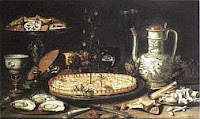 Delightes for Ladies (1602) was the first English book to provide a detailed description of how to make pastry dough. Originally published in 1602 and written by Sir Hugh Platt aka Plat, it includes recipes describing several sorts of pastry doughs including, as it relates to the development of mincemeat pies, puffe-paste aka puff pastry.
Delightes for Ladies (1602) was the first English book to provide a detailed description of how to make pastry dough. Originally published in 1602 and written by Sir Hugh Platt aka Plat, it includes recipes describing several sorts of pastry doughs including, as it relates to the development of mincemeat pies, puffe-paste aka puff pastry.Delightes for Ladies To adorne their Persons, Tables, Closets and Distillatories: with Beauties, Banquets, Perfumes and Waters
By Hugh Plat
At London Printed by Humfrey Lownes 1609
Recipe 24
To make puffe-paste
"Take a quart of the finest flower ,and the whites of three egges, and the yolks of two, & a little cold water, and so make it into perfect paste: then drive it with a rowling pin abroad: then put on small peeces of butter, as big as nuts, upon it: then fold it over: then drive it abroad again: then put small peeces of butter upon it, as you did before: doe this ten times, alwaies folding the paste, and putting butter between every fold. You may convey any preetty forced dish, as Florentin, Cherry-tart, Rise, or Pippins, &c, between two sheets of that paste."
The Second Part of The Good Hus-wives Jewell
by Thomas Dawson
At London Printed by Edward Allde for Edward White
1597
To bake a Connie, Veale, or Mutton
"Take a Conny and perboile it almoste enough, then mince the flesh of it verie fine, and take with it three yolkes of hard egges, and mince with it, then lay another Conny in your Pie being perboiled, and your minced meat with it, being seasoned with Cloues, Mace, Ginger, Saffron Pepper and Salt, with two dishes of swete butter mixed with it, lay vpon your Connie Barberies Gooseberies, or grapes, or the smal raisons, and so bake it."
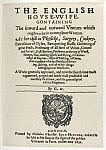 The English House-wife, Containing the Inward and Outward Virtues Which Ought to Be in a Complete Woman
The English House-wife, Containing the Inward and Outward Virtues Which Ought to Be in a Complete Womanby Gervase Markham (1568?-1637)
Printed at London by John Beale, for by Roger Jackson, and are to be sold at his shop neere the great Conduit in Fleet-Streete
1615
A minc't pie
"Take a Legge of Mutton, and cut the best of the flesh from the bone, and parboyle it well: then put to it three pound of the best Mutton suet, and shred it very small: then spread it abroad, and season it with Pepper and Salt, Cloues and Mace: then put in good store of Currants, great Raisins and Prunes cleane washt and pickt, a few Dates slic't, and some Orenge pills slic't: then being all well mixt together, put it into a coffin, or into diuers coffins, and so bake them: and when they are served up open the liddes, and strow store of Sugar on the top of the meate, and upon the lid. And in this sort you may also bake Beefe or Veale; onely the Beefe would not bee parboyld, and the Veale will aske a double quantity of Suet."
 The Queen-like Closet, or Rich Cabinet: Stored with all manner of Rare Receipts for Preserving, Candying and Cookery. Very Pleasant and Beneficial to all Ingenious Persons of the Female Sex
The Queen-like Closet, or Rich Cabinet: Stored with all manner of Rare Receipts for Preserving, Candying and Cookery. Very Pleasant and Beneficial to all Ingenious Persons of the Female Sexby Hannah Woolley aka Hannah Wolley (1623-1677)
Printed for Richard Lowndes at the White Lion in Duck-Lane, near West-Smithfield
1672, 344 pages.
Good minced Pies
"To make good minced Pies take one pound and half of Veal parboiled, and as much Suet, shred them very fine, then put in 2 pound of Raisins, 2 pound of Currans, 1 pound of Prunes, 6 Dates, some beaten Spice, a few Caraway seeds, a little Salt, Verjuice, Rosewater and Sugar, to fill your Pies, and let them stand one hour in the Oven: When they go to Table strew on fine Sugar."
(Editor's note: Verjuice is a vinegar-like juice.)
Woolley's The Queen-like Closet is significant in part because, taken as a whole, the books of Hannah Woolley were partly responsible for creating the very social and economic norms that made her recipes and instructions intelligible. Woolley's books were popular especially because of their social instructional nature. She may be likened to the Martha Stewart of her day. Even The Queen-like Closet, or Rich Cabinet includes considerable instruction on manners. Woolley was an authoritative and highly successful author in her time and she is notable as an early and vocal champion of women's education.
Continuing Trends in Mince Pie Recipes in the 18th and Early Century
 Receipts of Pastry and Cookery For the Use of his Scholars
Receipts of Pastry and Cookery For the Use of his Scholarsby Edward Kidder (1665?-1739)
circa 1700 to 1720
Puff Past
"Lay down a pound of flower and break into it two ounces of butter and two eggs then make it into past with cold water then work the other part of the pound of butter to the stiffness of your past then roul out your past into a square piece stick it all over with bitts of butter flower it and roul it up like a collar double it up at both ends that they meet in the middle roul it out again as aforesaid till all the pound of butter is in."
two recipes from The Art of Cookery Made Plain and Easy
by Mrs. Glasse
1805 (first published in 1747)
To make Mince-Pies the best Way
"Take three pounds of suet shed very fine, and chipped as small as possible; two pounds of raisins stoned, and chopped as fine as possible; two pounds of currants nicely picked, washed, rubbed, and dried at the fire; half a hundred of fine pippins, pared, cored, and chipped small; half a pound of fine sugar pounded fine; a quarter of an ounce, of mace, a quarter of an ounce of cloves, two large nutmegs, all beat fine; put all together into a great pan, and mix it well together with half a pint of brandy, and half a pint of sack; put it down close in a stone pot, and it will keep good four months. When you make your pies, take a little dish, something bigger than a soup plate, lay a very thin crust all over it, lay a thin layer of meat, and then a thin layer of citron cut very thin, then a layer of mince-meat, and a layer of orange-peel cut thin, over that a little meat, squeeze half the juice of a fine Seville orange or lemon, lay on your crust, and bake it nicely. These pies eat finely cold. If you make them in little patties, mix your meat and sweet-meats accordingly. If you chuse meat in your pies, parboil a neat's-tongue, peel it, chop the meat as fine as possible, and mix with the rest; or two pounds of the inside of a surloin of beef boiled."
Puff-Paste
"Take a quarter of a peck of flour, rub in a pound of butter very fine, make it up in a light paste with cold water just stiff enough to work it up; then roll it out about as thick as a crown-piece, put a layer of butter all over, sprinkle on a little flour, double it up and roll it out again; double it, and roll it out seven or eight times; then it is fit for all sorts of pies and tarts that require a puff-paste."
 two recipes from The Experienced English Housekeeper
two recipes from The Experienced English Housekeeperby Elizabeth Raffald
London, Printed for R. Baldwin No. 47, in Pater-Noster-Row
1786
A Mince Pye
"BOIL a neat's tongue two hours, then skin it, and chop it as small as possible, chop very small three pounds of fresh beef suet, three pounds of good baking apples, four pounds of currants clean washed, picked and well dried before the fire, one pound of jar raisins stoned, and chopped small, and one pound of powder sugar, mix them all together with half an ounce of mace, the same of nutmeg grated, cloves and cinnamon a quarter of an ounce of each, and one pint of Frency Brandy, and make a rich puff paste; as you fill the pye up, put in a little candied citron and orange cut in little pieces, what you have to spare; put close down in a pot and cover it up, put no citron or orange in till you use it."
To make a Mince Pye without Meat
"CHOP fine three pounds of suet, and three pounds of apples, when pared and cored, wash and dry three pounds of currants, stone and chop one pound of jar raisins, beat and sift one pound and a half of loaf sugar, cut small twelve ounces of candied orange peel, and six ounces of citron, mix all well together with a quarter of an ounce of nutmet, half a quarter of an ounce of cinnamon, six or eight cloves, and half a pint of French brandy, pot it close up, and keep it for use."
 A Complete System of Cookery on a Plan Entirely New
A Complete System of Cookery on a Plan Entirely Newby John Simpson
1816
MINCE PIES
"Seven pounds of currants, rubbed and picked very clean, three pounds and a half of beef suet, chopped very fine; three pounds and a half of lean beef (the inside of the sirloin is best if convenient) minced very fine, the beef should not be drest; three pounds and a half of apples chopped very fine, a quarter of a pound of citron, half a pound of lemon, half a pound of orange peel, all cut very fine; two pounds of moist sugar, one once of fine spice, such as cloves, nutmegs, and cinnamon, all pounded and sifted; grate the rind of six lemons and six Seville oranges. When all selected mix the currants and apples first, then the meat and suet; rub all well together five or six times over; the lemon peel, orange peel, citron, and spice the last; when all rubbed well together put it into a deep pot, and put over it one pint of brandy and one pint of sherry, the juice of the lemons and oranges that have been grated; then press it down well with the hand, then put one pint of brandy and one pint of sherry on the top, to soak down by degrees; cover the mince meat over. N. B. It ought to be made at least a fortnight before it is wanted; it will keep the year round. The mince pie pans should be sheeted with puff paste; as for the time they will take in baking, it depends on the oven; a quick oven is best."
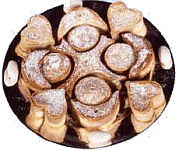 The Practice of Cookery, Pastry, and Confectionary
The Practice of Cookery, Pastry, and Confectionaryby Mrs. Frazer
Printed for the author and sold at her house, Miln's Square, Opposite the Tron Church
1820
Superfine Christmas Mince-pies
"After a large bullock's tongue has lain twenty-four hours in salt, take it up, wash it clean, and give it a boil three quarters of an hour : let it stand till it is cold, then cut it down, and mince it : take three pounds of beef suet, three pounds of stoned raisins, the same of cleaned currants, a dozen of pared apples, and mince them separately; take also half a pound of orange-peel, and one pound of almonds cut small, an ounce of cinnamon, and half an ounce of cloves beat; two nutmegs grated, the grate of two large lemons, the juice of three, and a bottle of white wine : mix the whole well together, and press it down into a can, the mouth of which must be tied up with paper, to keep out the air. When you have occasion to use it, line some patty cans with puff-paste, and fill them with the meat, nicking the upper crust with a knife. If the meat is intended to be kept long, leave out the apples and suet, as they are apt to spoil, and put them in fresh when there is occasion to use the meat."
Modern and familiar iterations of mincemeat
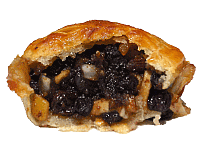 Domestic Cookery: Useful Receipts, and Hints to Young Housekeepers (1859)
Domestic Cookery: Useful Receipts, and Hints to Young Housekeepers (1859)by Elizabeth E. Lea (1793-1858)
The following are three mince pie recipes from this cookbook, originally compiled in 1842 and first published in 1845. The compilation was based on the author's accumulation of recipes for personal use beginning about 1821. It is a compilation of everything the author, as a cook, considered useful to remember. Lea's collection emphasized simple recipes as well as including everyday techniques and hints that people of the time took for granted. This cookbook is notable for its unusually complete recipes for the time. The author also often included additional information about substitutions or suggestions based on varieties of taste as well as fashion. It is also important to note that Lea tested each of her recipes, usually several times each. The third of Lea's mince pie recipes included here is notable as an indication of the continuing usefulness of mince pies as a way of keeping and preserving food.
 Rich Mince Pies
Rich Mince Pies"Take four pounds of beef, boiled and chopped fine; pick and chop three pounds of suet, wash two pounds of currants, and one of raisins; grate the peel of two lemons, and put in the juice; pound a spoonful of dried orange peel, slice an ounce of citron, and chop twelve large apples; mix these together with three pounds of sugar, half a pint of wine, and the same of brandy -- and sweet cider to make it a proper thickness; put in mace and nutmeg to your taste. If the cider is not sweet, you must put in more sugar before the pies are baked; cut several places in the top of each with a pair of scissors."
Mince Pies not so Rich
"Take four pounds of beef after it has been boiled and chopped, one of suet, two of sugar, two of raisins, and four of chopped apples; mix these together with a pint of wine and cider. to make it thin enough; season to your taste with mace, nutmeg and orange peel; If it is not sweet enough, put in more sugar. Warm the pies before they are eaten. Where persons are not fond of suet, put butter instead, and stew the apples instead of making so much cider."
 Farmers' Mince Pies
Farmers' Mince Pies"When you kill a beef, save the head for pies; it is some trouble to prepare it, but it is very nice for the purpose. Split the head, take out the brains and eyes, wash it well in cold water, and soak it all night with two hog's heads that have been cleaned; in the morning, boil them till you can take out the bones easily; skim off the froth as it rises, or it will stick to the meat; pick out the bones, and chop it fine, with three pounds of suet. This should be done the day before you want to bake."
"Mix to this quantity of meat, two gallons of chopped apples, four pounds of raisins, half a gallon of boiled molasses, a pint of currant wine, a tea-cup of rose brandy, an ounce of cinnamon, orange peel and mace, from two to four nutmets, and sweet cider enough to make it the right thickness; if the cider is not sweet, put in more molasses; when all is mixed it is best to bake a small pie, as you can alter the seasoning, if it is not to your taste. If you have not raisins, dried cherries or small grapes, that have been preserved in molasses, are very good, or stewed dried apples, instead of green; and where you have no cider, stew the apples in plenty of water, so as to have them very soft; a little good vinegar, sweetened and mixed with water, also does instead of cider, but is not so good."
"This will make about forty pies, and if you have a convenient way of keeping them, you may bake all at once, as they will keep for two months very readily when the weather is cold. If you do not bake all at once, put what is left in a jar, cover the top with melted suet, and over this put a piece of white paper, with a tea-cup of spirits poured on the top; tie it up and keep it where it will not freeze. Where persons have a large family, and workmen on a farm, these pies are very useful."
 In the late 19th century, recipes began to appear in a form familiar to modern cooks in which exact measurements are provided. The cookbook most noted for indicating this trend is the very well recognized the Boston Cooking-school Cook Book aka the Fannie Farmer Cookbook (1896) by Fannie Merritt Farmer.
In the late 19th century, recipes began to appear in a form familiar to modern cooks in which exact measurements are provided. The cookbook most noted for indicating this trend is the very well recognized the Boston Cooking-school Cook Book aka the Fannie Farmer Cookbook (1896) by Fannie Merritt Farmer.Exceptional for her time, Farmer was strict in her adherence to measurements in recipes. In addition to recipes that can still be prepared as Fannie wrote them today, Fannie wrote about the history of food, the science of food and the simple mechanics of food preparation. A fascinating record of how people cooked in the late 19th century and considered by some to be the greatest American cookbook, Fannie Merritt Farmer's Boston Cooking-School Cook Book, published over a century ago, and it was immediately acclaimed for a number of innovations. It was the first to use terms now considered standard in American cooking (e.g. a level cupful, teaspoonful and tablespoonful); it relied on simple directions and showed a hitherto neglected concern for nutrition. Novices as well as practiced cooks of the period were treated to a vast amount of information that left nothing to the user's imagination — from instructions for building a fire to how to bone a bird.
 The illustrated book also contains product advertisements. Today's cooks will find step-by-step instructions for preparing an enormous array of dishes, including such early American fare as fried corn meal mush, baked cod with oyster stuffing and tipsy pudding; adaptations of continental cuisine — quenelles and loin of veal à la jardinière — as well as hundreds of recipes for beverages, breads, pastries, meat, vegetable and poultry dishes, soups, salads, hot and cold desserts and much more. Glossary, Course of Instruction, Practice Lessons, Index, 40 halftones. (from the publisher of a 1997 facsimile edition)
The illustrated book also contains product advertisements. Today's cooks will find step-by-step instructions for preparing an enormous array of dishes, including such early American fare as fried corn meal mush, baked cod with oyster stuffing and tipsy pudding; adaptations of continental cuisine — quenelles and loin of veal à la jardinière — as well as hundreds of recipes for beverages, breads, pastries, meat, vegetable and poultry dishes, soups, salads, hot and cold desserts and much more. Glossary, Course of Instruction, Practice Lessons, Index, 40 halftones. (from the publisher of a 1997 facsimile edition)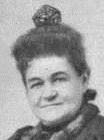 Here are recipes, very similar to Fannie Farmer's, from the less familiar cookbook Common Sense in the Household: A Manual of Practical Housewifery by Marion Harland (1893). Note that among these recipes are versions of Mincemeat without any meat in them, a type of mincemeat pie filling most familiar to contemporary American consumers. Also, Marion Harland was the pen name of Mary Virginia Terhune.
Here are recipes, very similar to Fannie Farmer's, from the less familiar cookbook Common Sense in the Household: A Manual of Practical Housewifery by Marion Harland (1893). Note that among these recipes are versions of Mincemeat without any meat in them, a type of mincemeat pie filling most familiar to contemporary American consumers. Also, Marion Harland was the pen name of Mary Virginia Terhune.pages 341-344
(i.e., Mince Pies numbers one and two, Apple Mince-meat, and Mock Mince-meat)
Mince Pies (No. 1.)
4 lbs. meat—i.e., two-thirds apple, one-third meat.
3 lbs. raisins, seeded and chopped.
2 lbs currants, washed, picked over, and dried.
3 quarts cider.
1 pint brandy.
1 heaping teaspoonful cinnamon.
1 heaping teaspoonful nutmeg.
The same of cloves, and half the quantity of mace.
Make very sweet with brown sugar.
The meat should be a good piece of lean beef, boiled the day before it is needed. Half a pound of raw suet, chopped fine, may be added. Chop the meat, clean out bits of skin and gristle, and mix with twice the quantity of fine juicy apples, also chopped; then put in the fruit, next the sugar and spice, lastly the liquor. Mix very thoroughly, cover closely, and let all staud together for twenty-four hours before making the pies.
 Mince Pies (No. 2.)
Mince Pies (No. 2.)2 lbs. lean fresh beef, boiled, and when cold, chopped fine.
1 lb. beef-suet, cleared of strings and minced to powder.
5 lbs. apples, pared and chopped.
2 lbs. raisins, seeded and chopped.
1 lb. sultana raisins, washed and picked over.
2 lbs. currants, washed and carefully picked over,
3/4 lb. citron, cut up fine.
2 tablespoonfuls cinnamon.
1 teaspoonful powdered nutmeg.
2 tablespoonfuls mace,
1 tablespoonful cloves.
1 tablespoonful allspice.
1 tablespoonful fine salt.
2 1/2 lbs. brown sugar.
1 quart brown Sherry.
1 pint best brandy.
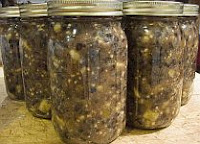 Mince-meat made by this receipt will keep all winter in a cool place. Keep in stone jars, tied over with double covers. Add a little more liquor (if it should dry out), when you make up a batch of pies. Let the mixture stand at least twenty-four hours after it is made before it is used.
Mince-meat made by this receipt will keep all winter in a cool place. Keep in stone jars, tied over with double covers. Add a little more liquor (if it should dry out), when you make up a batch of pies. Let the mixture stand at least twenty-four hours after it is made before it is used.Lay strips of pastry, notched with a jagging-iron, in a cross-bar pattern, upon the pie, instead of a top-crust.
Apple Mince-Meat.
2 lbs. apples—pared and chopped.
3/4 lb. beef suet—cleared of strings and powdered.
1 lb. currants.
1/2 lb. raisins, seeded and chopped,
i/2 lb sultana raisins,
i/4 citron, cut into shreds.
1 lemon—juice and grated rind.
1 tablespoonful cinnamon.
1 teaspoonful cloves.
1 teaspoonful mace.
1 tablespoonful allspice.
2 lbs. brown sugar.
Half-pint best brandy.
A glass of wine.
2 teaspoonfuls salt.
Pack down in a stone jar, with close cover, and keep in a cool place.
Mock Mince-meat.
6 soda crackers—rolled fine.
2 cups cold water.
1 cup molasses.
1 cup brown sugar.
1 cup sour cider,
l 1/2 cup melted butter.
1 cup raisins—seeded and chopped.
1 cup currants.
2 eggs—beaten light.
1 tablespoonful cinnamon and allspice mixed.
1 teaspoonful nutmeg.
1 teaspoonful cloves,
1 teaspoonful salt.
1 teaspoonful black pepper
1 wineglass of brandy.

A quick survey of the earliest occurrences the English word mince, as related to pies and cooking, from the Oxford English Dictionary
"O Lorde, he hath supped up all the brothe of this mince pie." (1573)
"Chopte or minsed meate." (1578)
"Pies of minced meate, and rice." (1585)
Frilingotti, a kinde of daintie chewet or mincedpie. (1598)
"Ten thousand in London swore to feast their neighbors with nothing but plum-porredge, and mince-pyes all Christmas." (1604)
"With a good strong Chopping-knife, mince the two Capons..as small as ordinary Minced Meat." (1626)
"If his wife puts but two fingers daintily into a dish of mince-meat, he sweares she makes hornes at him." (1630)
"We have, besides a good chine of beef and other good cheer, eighteen mince-pies in a dish, the number of the years that he hath been married." (1662)
"For currants to make mince-pyes with." (1673)

Resources
Pre-1600 Historical Cookbooks, Recipes and Culinary Texts
The Forme of Cury (circa 1390)
The Forme of Cury, A Roll of Ancient English Cookery (circa 1390)
Two Fifteenth-Century Cookery-Books edited by Thomas Austin (1888)
Noble Boke off Cookry Ffor a Prynce Houssolde or eny other Estately Houssolde
Gode Cookery
Medieval Cookery Books in English
Medieval Cookery
Historic Food
The Food Timeline
Das Kochbuch der Sabina Welserin (1553)
Das Kochbuch der Sabina Welserin (1553)
A Proper newe Booke of Cokerye (circa 1557)

Matthew Parker at the New World Encyclopedia
Matthew Parker at Wikipedia
Matthew Parker from Lives of the Archbishops of Canterbury (1872)
Matthew Parker (within the text of an 1806 history of Norfolk) at British History Online
Margaret Parker aka Margaret Harleston at author Kate Emerson's web site
The Parker Library of Corpus Christi College, Cambridge
The Parker Library collection if imaged manuscript titles
Delightes for Ladies (1602) partial transcription
Cobham family portrait
Clara Peeters (1594-c1657)
Gervase Markham in the The English Housewife (1615) facsimile edited by Michael R. Best
Gervase Markham at Wikipedia
The English Hus-wife (1615) partial transcription

Hannah Wolley: Her Life and Works
Hannah Woolley in A Historical Dictionary of British Women (2003)
Hannah Woolley from Dickens' Household Words, Volume XII (1856-1857)
Hannah Woolley in The Atlantic Monthly, Volume LXXXVII (1901)
Receipts of Pastry and Cookery For the Use of his Scholars by Edward Kidder
Receipts of Pastry and Cookery For the Use of his Scholars by Edward Kidder
The Whole Duty of a Woman: Or, an infallible Guide to the Fair Sex (1737)
Edward Kidder in Something for Everybody by John Timbs (1861)
Edward Kidder from A History of the Kidder Family (1886)
The Art of Cookery Made Plain and Easy by Mrs. Glasse (1805)
The Experienced English Housekeeper by Elizabeth Raffald (1786)
A Complete System of Cookery on a Plan Entirely New by John Simpson (1816)
The Practice of Cookery, Pastry, and Confectionary by Mrs. Frazer (1820)
Domestic Cookery by Elizabeth Lea (3rd ed, 1851) at Project Gutenberg
Elizabeth Lea from a 1986 facsimile edition of Domestic Cookery (5th ed, 1853)
The Modern Cook by Charles Elmé Francatelli (1862)
Charles Elmé Francatelli at Wikipedia
Fannie Merritt Farmer at Wikipedia
Mary Virginia Terhune aka Marion Harland at Wikipedia

Home
Older Article: Alicia Gaspar de Alba, Chicana Scholar, Novelist and Poet


